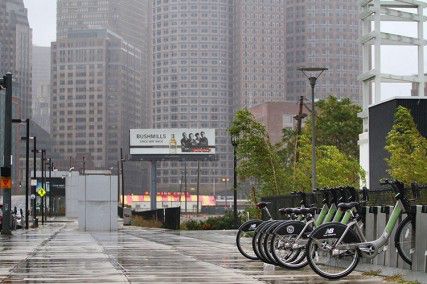
Within the next year, departments such as Massport and the Massachusetts Bay Transportation Authority will work on developments in South Boston’s Innovation District after Boston Mayor Thomas Menino announced a number of transportation improvements on Wednesday to accommodate the influx of workers commuting daily through the area.
Terence Burke, spokesman for A Better City, a nonprofit organization that works with businesses on transportation development, said these improvements enable economic growth in an area that might otherwise be unequipped to accommodate the high traffic volume that comes with an expanding neighborhood.
“These agencies are coming together with the city of Boston to make these improvements … and to work on long-term planning that will improve the transportation in and out of the innovation district,” he said. “They’re working to ensure that this important part of the city continues to thrive as a highly important and up-and-coming economic center.”
The City plans to re-strip the road surface on the Moakley Bridge to guide motorists out to the highway, install “Time to Destination” message signs that will provide drivers with information on traffic to allow them take alternate routes, and install “smart parking” sensors for drivers to use a phone app to show available parking spaces, according to a Wednesday press release from the mayor’s office.
Among these improvements is a ferry service that will launch in 2014 and run between East Boston and South Boston, re-routing commuters between those two neighborhoods and decreasing the volume of downtown traffic, according to the release.
“The Innovation District and seaport are gateways to Boston for people and goods traveling by air and sea from across the world,” said Massport CEO Thomas Glynn in the release. “Immediate and long-term improvements … ensure that the Innovation District, Logan Airport and our port can reach their fullest potential without being restricted by congestion.”
Some daily commuters in South Boston said a ferry service would solve traffic problems in the neighborhood.
Dyllan Nguyen, 23, who works at the Eliot School in Jamaica Plain, said he commutes to South Boston every day.
“I feel like it would help a lot,” he said. “South Boston is becoming a hub, a lot of people are moving here, so it would encourage commuters to go around the neighborhood instead of plowing through the middle of it.”
Other South Boston commuters said the ferry might not solve some of the transportation issues in the area.
Raymond Mollon, resident of Brockton who works in South Boston, said he is skeptical that a ferry service can address the area’s significant traffic problems.
“A ferry over to East Boston really isn’t going to change the traffic pattern,” he said. “There aren’t going to be enough people to take the boat, at least not enough to make a dent in the typically congested areas. When you consider how many commuters go through South Boston each day, [a ferry is] not going to change that much.”
Emma Rose, 24, an employee at the Boston Children’s Museum, said the neighborhood faces more urgent transportation issues that the ferry does not mitigate and that additional train and bus routes are needed more than a ferry.
“Every single person who wants to get to South Boston from anywhere else in the city … has to get off at that one station [South Station] and then wait for the Silver Line or cross the bridge,” she said. “As long as the T’s running, they shouldn’t be doing maintenance like this. I get why people want all these improvements, but it’s not worth the hassle. They need to reconsider when they’re doing construction.”
Mollon said South Boston is changing for the better and it is time for the City of Boston to rise to the occasion and properly fund improvements.
“This is an up-and-coming neighborhood in Boston and it’s the last area to be developed,” he said. “The city needs to concentrate its resources here to accommodate an area that’s becoming a huge tourist destination.”
Jill Callahan, 31, a resident of South Boston, said she is not as eager for the neighborhood to change.
“It’s great that they’re finally investing in South Boston,” she said. “But the community is very different from what it was a decade ago. The expansion on the T is bringing in a lot of people who don’t know the neighborhood. [It’s not] a tight-knit community anymore.”
This is an account occasionally used by the Daily Free Press editors to post archived posts from previous iterations of the site or otherwise for special circumstance publications. See authorship info on the byline at the top of the page.



